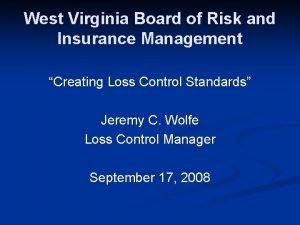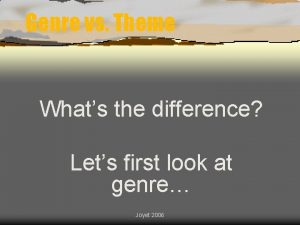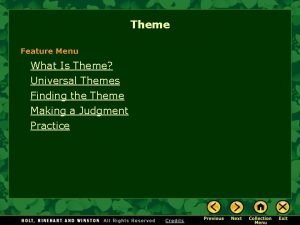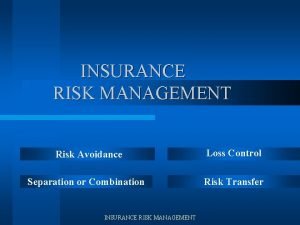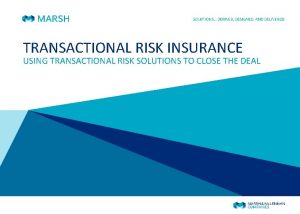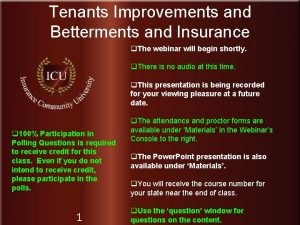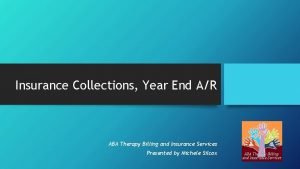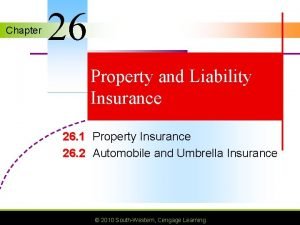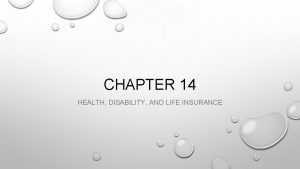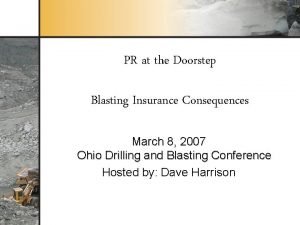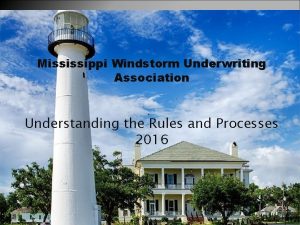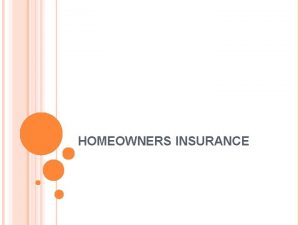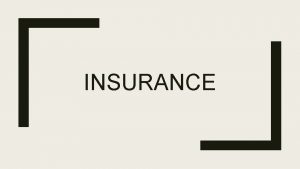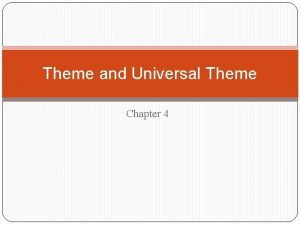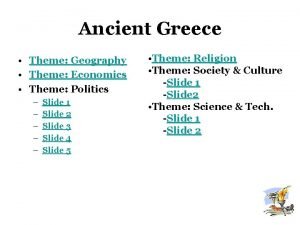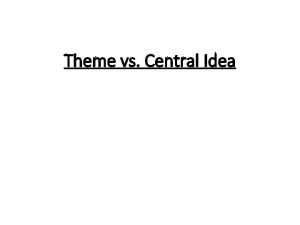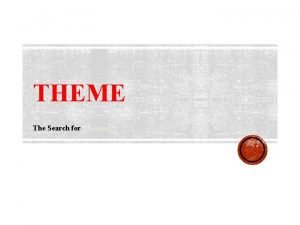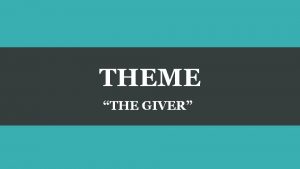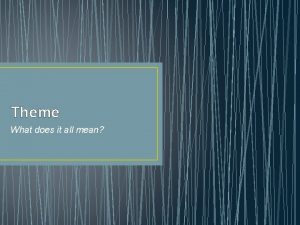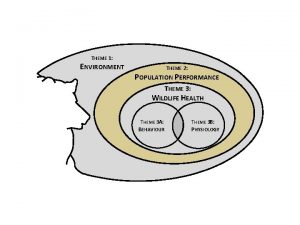Theme 6 Risk and Insurance Risk Risk is




























- Slides: 28

Theme 6: Risk and Insurance







Risk • Risk is a state of uncertainty where certain situations may result in loss or another undesirable outcome. • Pure risk: is a chance of loss with no chance for gain. Example: accidents resulting in physical injury Illness/Death Destructive acts of nature • In order to reduce negative consequences of risk (and in particular, pure risk), what has been created?

Insurance • Insurance: a method for spreading individual risk among a large group of people to make losses more affordable for all. • Insurable risk: is a pure risk that is faced by a large number of people and for which the amount of the loss can be predicted.

Types of Insurance • Personal risk: is the chance of loss involving your income and standard of living. o life, health, and disability insurance • Property risk: is the chance of loss or harm to personal or real property o home, car, or other possessions could be damaged or destroyed by fire, theft, wind, rain, accident, and other hazards. • Liability risk: is the chance of loss that may occur when your errors or actions result in injuries to others or damages to their property. o liability when driving, on the job

How It Works • There is risk all around us. (you could fall, get in an accident, get mugged…) • If there is a predictable risk, a group of people could spread the risk by paying in small amounts (premiums) over time, and pool that money to cut back on financial weight of those risks. • Example: If you have 25 students in a room, and we can assume that one of you will be in a car accident in the next year which will cost $10, 000, an insurer can allow you all to pool your resources. How do we determine each student’s premium?

How It Works (Continued…) $10, 000/25 = $400 person over 12 months $400/12 = $33. 34/month • Insurers set premiums based on statistical probability by estimating the potential losses through a number of criteria and data. • The higher probability of loss occurring, the higher the premiums. • Why does Florida have very high property tax?

• Insurance is not meant to enrich- only to compensate for actual losses incurred. o Indemnification: is the process of putting the policyholder back in the same financial condition he or she was in before the loss occurred. o Underinsured: is when one has insurance, but it does not bring them back to a state financial equilibrium after damage has occurred. (in the event of a claim, the owner of the policy will take a loss…an “L”)

Winners v. Losers • Winners are individuals who pay more in premiums than their costs for what is insured. o Examples? • Losers are individuals whose costs exceed their premiums. o Examples? • Pre-Existing Conditions => Often seen to be predetermined losers o What are examples of pre-existing conditions?

Insurers Economic Model • As For-Profit industries, how do insurance companies make money? • Profit = (earned premium + investment income) - (incurred loss + underwriting expenses) • Float: available money that an insurer has collected from premiums, but has not paid out in claims. o The float is invested and collects interest until claims need to be paid out.

Risk Management • While you cannot eliminate risk, you can manage it. • risk management: is an organized strategy for controlling financial loss from pure risk. 1) Identify risk 2) Assess seriousness of risk (Risk Assessment) 3) Handle Risk o Risk shifting or Risk transfer: pass risk to another (buy insurance) o Risk avoidance: don’t engage in the activity that could result in the loss. o Risk reduction: take measures to lower the chance of risk (fire alarms, security systems, seat belts, don’t smoke) o Risk Assumption: accept the consequences of risk (self insure by saving money for smaller risks, don’t insure a beat up car for as much and pay for your own repairs)

Reducing Costs • Lower your deductible (the specified amount of a loss that the insured must pay before the insurer’s obligation to pay begins. o The higher the deductible ($1500 v. $500), the less you pay in premiums. o Beware: you don’t want your deductible to be a reason not to take care of yourself. • Group insurance => insurance through a job or a credit union • Discount opportunities o For teenagers, go to drivers education and get good grades o Multi-line insurance- having more than one type of policy through the same company (home and auto)

Property Insurance • Renters Insurance (~$15 -$30/month) o personal property (if your property is damaged o personal liability (if someone is injured because you are liable even if it isn’t your fault) o Extended coverage- Often coverage might cover up to $25, 000, but if you have some expensive items and you want to extend the coverage, you can pay extra per month. Sometimes, it requires appraisals.

Homeowners Insurance • Homeowners insurance covers: • Hazards, Crimes, and Liability o Because water damage is a Hazard, if you have a leaking pipe or damage caused even by negligence, it may still be covered…ALWAYS ASK! o Liability coverage: homeowners are responsible for guests (someone you ask to come over) and uninvited guests (people who have permission like delivery people or even solicitors). • You are not responsible for trespassers. • An attractive nuisance is a dangerous place, condition or object that is attractive to children. For example, a pool. Even if the homeowner takes precautions, if something happens to a child who sneaks over, you are HELD LIABLE.

Auto Insurance • Cost • premiums are determined by: o o type of car (model, style, age) Driver classification (age, sex, marital status) Driving record Location (city, county) • Discounts: o Multi-policy discount: insuring more than one vehicle with the same insurer. o Getting good grades (usually B average or higher-high school and college) o Safety features

Auto • Types of coverage o Liability (if you injure another) o Collision (covers damage to your car if you are at fault) o comprehensive coverage (covers damage to your car from something other than a car accident…tree falls on it, vandalism, a deer runs out) o personal injury protection (PIP) (if you injure yourself or others in the car) o FULL COVERAGE is everything

Health and Life • Health insurance is a plan for sharing the risk of high medical costs resulting from injury or illness. o employment based insurance o individual plan (very expensive…why? ) o government plans (Medicaid or Medicare) • Types of coverage: o Basic health coverage- medical, hospital, and surgical costs o often does not include cosmetic or elective surgeries) o Major medical coverage- protect against catastrophic expenses of a serious injury or illness. o Dental and Vision

SLPS Plan

Managed Care Plans • Managed Care Plans rely on a network of health care professionals (“Is that doctor in your network? ”) • Health Maintenance Organization (HMO): a group plan offering prepaid medical care to its members. o Patients choose doctors on the HMO including primary care physician. o Primary Care Physician have to give the go ahead before you see any specialists (acting as a gatekeeper to keep costs down). o Preventative care is usually covered 100% to create an incentive to stay healthy. • Preferred Provider Organization (PPO): a group of health care providers (doctors and hospitals) who band together to provide health services for set fees. o This plan lets you go out of network, but charges more. o Because there is more flexibility, it is usually more expensive.

Government Health Care • Medicare: government-sponsored health insurance for people age 65 or older. o Run by Social Security Administration (SSA)- Premiums are deducted from social security payments. • Medicaid: government-sponsored health insurance for people with low-incomes and limited resources. o Medicaid is joint federal-state program with the federal government paying 50% of each state’s separate system.

Disability Insurance • Disability insurance: is an insurance plan that makes regular payments (usually monthly) to replace income lost when illness or injury prevents the insured from working. • Short-term: usually last between three and six months. • Long-term: Can go up to retirement.

Life Insurance • Life Insurance: provides funds to the beneficiaries when the insured dies. o One must consider the needs of their family after they die. Consider: how much income will be needed to pay the ongoing expenses of daily living. o Based off of personal and medical history, age, health, gender, and other variables. o Beneficiaries are those who receive the funds. (you can leave different percentages to different people) 1) Term (Temporary) life: life insurance that is temporary (example: it is a 20 year plan). 2) Permanent Life: remains in effect the insured’s full lifetime and builds cash value. (cash value is a savings accumulated in a permanent policy which you can receive if you cancel it. ) NOTE: You can take a loan against your life insurance policy. If you don’t pay it, the firm can take the money from the funds paid to your beneficiaries.

Healthcare System Design • If you were designing a healthcare system, what would it look like? • Assignment: o Need to create a healthcare system o Write down FIVE aspects of your healthcare system and how it works for the people you are designing it for.
 Functions of fire insurance
Functions of fire insurance West virginia board of risk and insurance management
West virginia board of risk and insurance management Marsh risk & insurance services
Marsh risk & insurance services Wharton risk center
Wharton risk center Market risk credit risk operational risk
Market risk credit risk operational risk What is the difference between theme and genre
What is the difference between theme and genre What is the difference between theme and universal theme?
What is the difference between theme and universal theme? Alan franklin
Alan franklin Separation risk control technique
Separation risk control technique Yem mai marsh
Yem mai marsh Risk management avoidance
Risk management avoidance Meaning and nature of risk
Meaning and nature of risk Sarvesh suri
Sarvesh suri Finite risk reinsurance
Finite risk reinsurance Theme for english b imagery
Theme for english b imagery What is universal theme?
What is universal theme? Residual risk and secondary risk pmp
Residual risk and secondary risk pmp Business risk and financial risk leverage
Business risk and financial risk leverage Attributable risk
Attributable risk Attributable risk
Attributable risk Improvements and betterments insurance
Improvements and betterments insurance Aba therapy billing and collections
Aba therapy billing and collections Climbs life and general insurance cooperative
Climbs life and general insurance cooperative Chapter 26 property and liability insurance
Chapter 26 property and liability insurance Chapter 14 health disability and life insurance
Chapter 14 health disability and life insurance Drilling and blasting insurance
Drilling and blasting insurance Types of reinsurance
Types of reinsurance Wind and hail insurance biloxi ms
Wind and hail insurance biloxi ms Garner and glover insurance
Garner and glover insurance

